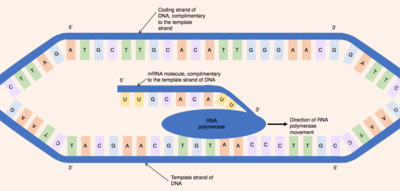Our website is made possible by displaying online advertisements to our visitors.
Please consider supporting us by disabling your ad blocker.
Coding strand

When referring to DNA transcription, the coding strand (or informational strand[1][2]) is the DNA strand whose base sequence is identical to the base sequence of the RNA transcript produced (although with thymine replaced by uracil). It is this strand which contains codons, while the non-coding strand contains anticodons. During transcription, RNA Pol II binds to the non-coding template strand, reads the anti-codons, and transcribes their sequence to synthesize an RNA transcript with complementary bases.
By convention, the coding strand is the strand used when displaying a DNA sequence. It is presented in the 5' to 3' direction.
Wherever a gene exists on a DNA molecule, one strand is the coding strand (or sense strand), and the other is the noncoding strand (also called the antisense strand,[3] anticoding strand, template strand or transcribed strand).
- ^ "28.4: Transcription of DNA". Chemistry LibreTexts. 2015-08-26. Retrieved 2021-09-06.
- ^ STOKER, H. STEPHEN (2013). General, Organic, and Biological Chemistry. Cengage Learning. p. 816.
- ^ Lewin, Benjamin (2008). Genes IX. Oxford University Press. p. 129, 235. ISBN 978-0-7637-4063-4.
Previous Page Next Page


